Structural Reliability Analysis of Wind Turbines: A Review
Abstract
1. Introduction
2. Methodologies of Structural Reliability Analysis
2.1. Definition of Structural Reliability Analysis
2.2. Methods of Structural Reliability Analysis
2.2.1. First- and Second-Order Reliability Methods
- Random variable transformation: The original space of the random vector is first transformed to a new n-dimensional space consisting of independent standard normal variables. The original limit state is then mapped to a new limit state in the -space.
- MPP identification: Having the shortest distance to the origin of the -space, the MPP is identified by using a proper nonlinear optimization algorithm.
- Limit-state approximation: The limit state is approximated by a hyperplane (linear or first-order) for FORM and a hyperparaboloid (quadratic or second-order) for SORM. The approximated limit states and are tangent to the limit state at the MPP, as shown in Figure 2.
- Probability calculation: The failure probability using FORM is calculated as:where is the shortest distance from the MPP to the origin of the -space and calculates the cumulative distribution function of the standard normal distribution at x. More sophisticated derivation is required for calculating the failure probability using SORM. For instance, Breitung’s asymptotic solution is expressed as [14]:where is the main curvatures of at the MPP. Interested readers may refer to details in the literature [14,15,16]. Experience has shown that FORM/SORM are sufficiently accurate for engineering purposes, provided that (1) the MPP is accurately identified, (2) the limit state curve/surface at the MPP is close to being linear or quadratic and (3) no multiple MPPs exist [16].
2.2.2. Simulation Reliability Methods
2.2.3. Other Reliability Methods
2.2.4. Modeling Uncertainties in Material Properties, Loads and Load Effects of Wind Turbines
- Physical uncertainty related to the natural randomness of a physical quantity. For example, variation of 10-min mean wind speed in one year and uncertainty of the material properties affecting the fatigue reliability of wind turbines. The physical uncertainty is often represented by traditional distributions and incorporated into SRA of wind turbines.
- Measurement uncertainty related to imperfect measurements. For example, the uncertainty of wind speed measurement using traditional cup anemometers would be larger than that from three-dimensional sonic anemometers. It is impossible to totally eliminate the measurement uncertainty, while using more advanced measurement techniques and instrumentation will probably reduce the measurement uncertainty and result in more accurate SRA results.
- Statistical uncertainty related to limited sample size; for example, probabilistic S-N curves due to limited test specimens of composite materials used in wind turbine blades. Although it is straightforward to reduce the statistical uncertainty by increasing the test sample size, more expenditure and time in sample purchasing and testing are often caused. An alternative strategy is to develop statistical methods that can accurately quantify the uncertainty with a small sample number. In stochastic dynamic simulations, a limited number of time-domain simulations with certain durations is performed for a load case. Increasing this number will reduce the statistical uncertainty at the cost of computational time.
- Model uncertainty related to imperfect modeling of the performances of OWTs in SRA. The model uncertainty can typically be expressed as follows:where represents the model uncertainty related to a physical variable F (e.g., aerodynamic loads). denotes the real value of this variable, and denotes the estimated value of this variable. Because of complicated physics and aero-hydro-servo-elastic coupling effects, high-fidelity modeling of an OWT is still a challenging task, and simplified approaches are often used. When simulating three-dimensional wind fields, Mann’s model [27], the IEC Kaimal model [4] or direct numerical simulation can be used to represent the turbulent wind field at varying fidelity levels. In the aerodynamic load calculation, the blade element momentum method, vortex method and computational fluid dynamics method will produce quite different load effects [28], in addition to the uncertainties associated with airfoil data. When generating irregular waves in the time domain, either linear or nonlinear wave theories can be applied [29]; the resultant wave kinematics will vary and affect the hydrodynamic loads especially for shallow-water conditions. Morison’s formula [30] or potential-flow theory is often used for hydrodynamic load calculation of offshore support structures. Then, drag and inertial coefficients related to Morison’s formula or viscous effects associated with large-volume structures contribute to the uncertainties in the hydrodynamic load effects. Model uncertainty also arises when using beam elements in the finite element models to represent the complex wind turbine blades in structural dynamics problems. This type of uncertainty can be reduced by implementing advanced structural analysis methods together with high-performance computing techniques.
3. Application of Structural Reliability Methods
3.1. Procedure for Structural Reliability Analysis of Wind Turbines
3.2. Application Areas
- The design of new structures;
- The calibration of safety factors in simplified design procedures;
- The reassessment of existing structures, taking explicit account of uncertainties in deterioration due to corrosion and wear;
- Inspection planning, taking explicit account of uncertainties in inspection results from various forms of nondestructive testing;
- Decision making under uncertainty;
- Probability calculation for a wide range of events.
3.2.1. Code Calibration for Design Standards
- Well-established cases that are known to have adequate safety;
- Safety levels established for similar existing structural design solutions that may be satisfactorily considered as being transferable;
- Accepted decision analysis techniques.
3.2.2. Probabilistic Methods for Inspection Planning
4. State-Of-The-Art Reliability Analysis of Wind Turbine Components
4.1. Overview
4.2. Rotor Blades
- Fatigue reliability analysis calculating the probability of blade fatigue life that is greater than a target lifespan under fatigue loadings.
- Extreme reliability analysis evaluating the probability of blade performances (e.g., deflection and stress/strain) that satisfy the designed threshold under extreme loading (e.g., wind gusts).
4.3. Bottom-Fixed Support Structures
4.3.1. Onshore Structures
4.3.2. Offshore Structures
4.4. Floating Systems
4.5. Mechanical and Electrical Components
5. Research Prospect
- Floating wind turbines:In recent years, the research and development of offshore wind energy has shifted from bottom-fixed OWTs in shallow waters to FWTs in deeper waters where benefits are present such as improved wind conditions, reduced wave loading and lesser visual impact. Various designs of FWT concepts have been proposed, and spar buoys, semisubmersibles and tension leg platforms are dominant types of support structures. The research focus is still on horizontal-axis wind turbines; see [129,130,131,132,133,134,135,136,137]. Clearly, many of these support structures and mooring systems are not designed based on the probabilistic approach, and great structural redundancies exist. As the reliability analysis methods and procedures for offshore structures are quite mature [138,139,140], it is expected that these methods will be extended and applied in the response-based optimal design of FWTs. However, it is still challenging, but critical to properly assess the model uncertainties in the load effects due to the controller behavior [141,142,143], site conditions [144], aerodynamic modeling [28,145] and load extrapolation methods [61,146].
- Drivetrain components:Most of the modern wind turbines use gearboxes as the medium for power transmission. The gearbox components, including bearings and gears, used to be designed by manufacturers that have limited knowledge of the system loads and responses. Consequently, failures of the gearbox components contribute substantially to the downtime of wind turbines. Since 2007, significant numerical modeling and dynamometer testing efforts have been done to investigate the root causes of component failures [51,52,54]. The physics-based reliability analysis has potential to be applied in bearing and gear design. For specific failure modes such as micropitting, white-etching area cracks and rolling contact fatigue, the limit-state functions can be formulated, and the mechanical components can be designed for a consistent reliability level. Because the damage development of the mechanical components is influenced by the operational conditions including unsteady wind, braking, generator misalignment, lubricants and grid faults [147], there is a need to address the uncertainties related to these factors. In addition to the traditional gear transmission, other types of drivetrain technologies including direct drive [148] and hydraulic transmission [149,150] have also appeared on the market, and the reliability of these novel technologies remains an open question.
- Reliability-based design optimization:Reliability-based design optimization (RBDO) is one promising extension of SRA. Studies by [22,45,62] show that RBDO brings more reliable and cost-effective designs than the deterministic approaches do. By using efficient sampling methods and RSMs, the computational costs of the optimization problem are also acceptable. Therefore, it is envisaged that RBDO will be more widely applied in the design process of wind turbine components. Ideally, if all structural components are designed according to a consistent reliability level, then the failure rates of OWTs are expected to decrease.
6. Conclusions
- Research on the reliability analysis of wind turbines is still focused on the rotor blades and bottom-fixed support structures, and there is strong potential to apply reliability methods in the design of floating wind turbines and the drivetrain components.
- When there is a lack of test data, the state-of-the-art approach for response-based probabilistic design includes coupled dynamic simulation for the global motion and finite element analysis for the detailed structural analysis. Some novel analysis approaches (e.g., incremental wind-wave analysis method and peak response factor method) do not involve dynamic analysis and should be exercised with caution. Most of the limit-state functions can be formulated based on the ultimate limit state or fatigue limit state. First- and second-order reliability methods or Monte Carlo simulations together with response surface methodologies are often used to evaluate the reliability index.
- Quantification of uncertainties is a critical element in reliability analysis. There are challenges especially for novel wind turbine structures. To facilitate the reliability-based design of wind turbines, future work is greatly needed for assessing the modeling uncertainties.
Acknowledgments
Author Contributions
Conflicts of Interest
Appendix A. Worked Example Using First-Order Reliability Method
| Variable | Mean Value () | Coefficient of Variation () | Distribution |
|---|---|---|---|
| m | 3.0 | 0 | Deterministic |
| k | 0 | Deterministic | |
| 1 | 0 | Deterministic | |
| 300 | 0.3 | Lognormal | |
| 0.4 | Lognormal |
References
- Pineda, I.; Tardieu, P. The European Offshore Wind Industry-Key Trends and Statistics 2016. Available online: https://windeurope.org/about-wind/statistics/offshore/european-offshore-wind-industry-key-trends-and-statistics-2016/ (accessed on 1 June 2017).
- Lazard Ltd. Lazard’s Levelized Cost of Energy Analysis—Version 10.0; Lazard Ltd.: Hamilton, Bermuda, 2016. [Google Scholar]
- Moné, C.; Hand, M.; Bolinger, M.; Rand, J.; Heimiller, D.; Ho, J. 2015 Cost of Wind Energy Review; Technical Report NREL/TP-6A20-66861; National Renewable Energy Laboratory: Golden, CO, USA, 2017.
- International Electrotechnical Commission. IEC 61400-1: Wind Turbines Part 1: Design Requirements; International Electrotechnical Commission: Geneva, Switzerland, 2005. [Google Scholar]
- International Electrotechnical Commission. IEC 61400-3: Wind Turbines—Part 3: Design Requirements for Offshore Wind Turbines; International Electrotechnical Commission: Geneva, Switzerland, 2009. [Google Scholar]
- Freudenreich, K.; Argyriadis, K. Wind turbine load level based on extrapolation and simplified methods. Wind Energy 2008, 11, 589–600. [Google Scholar] [CrossRef]
- Sichani, M.T.; Nielsen, S.; Naess, A. Failure probability estimation of wind turbines by enhanced Monte Carlo method. J. Eng. Mech. 2011, 138, 379–389. [Google Scholar] [CrossRef]
- EN 1990. Eurocode—Basis of Structural Design; CEN/TC 250; Thomas Telford: London, UK, 2002.
- Choi, S.K.; Grandhi, R.V.; Canfield, R.A. Reliability-Based Structural Design; Springer Science & Business Media: Berlin, Germany, 2006. [Google Scholar]
- Sørensen, J.D.; Toft, H.S. Probabilistic design of wind turbines. Energies 2010, 3, 241–257. [Google Scholar] [CrossRef]
- Tavner, P.; Xiang, J.; Spinato, F. Reliability analysis for wind turbines. Wind Energy 2007, 10, 1–18. [Google Scholar] [CrossRef]
- Ditlevsen, O.; Madsen, H.O. Structural Reliability Methods; Wiley: New York, NY, USA, 1996; Volume 178. [Google Scholar]
- Melchers, R.E. Structural Reliability: Analysis and Prediction; Horwood: Chichester, UK, 1987. [Google Scholar]
- Breitung, K. Asymptotic approximations for multinormal integrals. J. Eng. Mech. 1984, 110, 357–366. [Google Scholar] [CrossRef]
- Hohenbichler, M.; Rackwitz, R. Improvement of second-order reliability estimates by importance sampling. J. Eng. Mech. 1988, 114, 2195–2199. [Google Scholar] [CrossRef]
- Rahman, S.; Wei, D. A univariate approximation at most probable point for higher-order reliability analysis. Int. J. Solids Struct. 2006, 43, 2820–2839. [Google Scholar] [CrossRef]
- Veers, P. Fatigue Reliability of Wind Turbine Components; Report; Sandia National Labs.: Albuquerque, NM, USA, 1990.
- Dong, W.; Moan, T.; Gao, Z. Fatigue reliability analysis of the jacket support structure for offshore wind turbine considering the effect of corrosion and inspection. Reliab. Eng. Syst. Saf. 2012, 106, 11–27. [Google Scholar] [CrossRef]
- Au, S.K.; Beck, J.L. Estimation of small failure probabilities in high dimensions by subset simulation. Probab. Eng. Mech. 2001, 16, 263–277. [Google Scholar] [CrossRef]
- Olsson, A.; Sandberg, G.; Dahlblom, O. On Latin hypercube sampling for structural reliability analysis. Struct. Saf. 2003, 25, 47–68. [Google Scholar] [CrossRef]
- Mori, Y.; Ellingwood, B.R. Time-dependent system reliability analysis by adaptive importance sampling. Struct. Saf. 1993, 12, 59–73. [Google Scholar] [CrossRef]
- Hu, W.; Choi, K.; Cho, H. Reliability-based design optimization of wind turbine blades for fatigue life under dynamic wind load uncertainty. Struct. Multidiscip. Optim. 2016, 54, 953–970. [Google Scholar] [CrossRef]
- Pourazarm, P.; Caracoglia, L.; Lackner, M.; Modarres-Sadeghi, Y. Perturbation methods for the reliability analysis of wind-turbine blade failure due to flutter. J. Wind Eng. Ind. Aerodyn. 2016, 156, 159–171. [Google Scholar] [CrossRef]
- Wei, K.; Arwade, S.R.; Myers, A.T. Incremental wind-wave analysis of the structural capacity of offshore wind turbine support structures under extreme loading. Eng. Struct. 2014, 79, 58–69. [Google Scholar] [CrossRef]
- Kim, D.H.; Lee, S.G. Reliability analysis of offshore wind turbine support structures under extreme ocean environmental loads. Renew. Energy 2015, 79, 161–166. [Google Scholar] [CrossRef]
- Teixeira, R.; O’Connor, A.; Nogal, M. Comparative analysis of the probabilistic methods to estimate the probability of failure of offshore wind turbine towers. In Proceedings of the Civil Engineering Research in Ireland Conference (CERI 2016), Galway, Ireland, 29–30 August 2016; pp. 29–30. [Google Scholar]
- Mann, J. Wind field simulation. Probab. Eng. Mech. 1998, 13, 269–282. [Google Scholar] [CrossRef]
- Hansen, M.O.; Madsen, H.A. Review paper on wind turbine aerodynamics. J. Fluids Eng. 2011, 133, 114001. [Google Scholar] [CrossRef]
- Det Norske Veritas. DNV-RP-C205: Environmental Conditions and Environmental Loads; Det Norske Veritas: Oslo, Norway, 2010. [Google Scholar]
- Morison, J.; Johnson, J.; Schaaf, S. The force exerted by surface waves on piles. J. Pet. Technol. 1950, 2, 149–154. [Google Scholar] [CrossRef]
- Det Norske Veritas & Germanischer Lloyd SE. DNVGL-RP-C203: Fatigue Design of Offshore Steel Structures; Det Norske Veritas & Germanischer Lloyd SE: Oslo, Norway, 2016. [Google Scholar]
- Det Norske Veritas & Germanischer Lloyd SE. DNVGL-RP-C210: Probabilistic Methods for Planning of Inspection for Fatigue Cracks in Offshore Structures; Det Norske Veritas & Germanischer Lloyd SE: Oslo, Norway, 2015. [Google Scholar]
- Det Norske Veritas. Offshore Standard DNV-OS-J101: Design of Offshore Wind Turbine Structures; Technical Report; Det Norske Veritas: Oslo, Norway, 2010. [Google Scholar]
- Germanischer Lloyd. Guideline for the Certification of Wind Turbines; GL Renewables Certification: Hamburg, Germany, 2010. [Google Scholar]
- Márquez-Domínguez, S.; Sørensen, J.D. Fatigue reliability and calibration of fatigue design factors for offshore wind turbines. Energies 2012, 5, 1816–1834. [Google Scholar] [CrossRef]
- Moan, T. Reliability-based management of inspection, maintenance and repair of offshore structures. Struct. Infrastruct. Eng. 2005, 1, 33–62. [Google Scholar] [CrossRef]
- Faber, M.; Engelund, S.; Sørensen, J.D.; Bloch, A. Simplified and generic risk based inspection planning. In Proceedings of the OMAE 2000 Conference, New Orleans, LA, USA, 14–17 February 2000. [Google Scholar]
- Sørensen, J.D.; Faber, M.H. Generic inspection planning for steel structures. In International Conferene on Structural Safety and Reliability; Balkema Publishers, AA/Taylor & Francis: Rotterdam, The Netherlands, 2002. [Google Scholar]
- Sørensen, J.D. Framework for risk-based planning of operation and maintenance for offshore wind turbines. Wind Energy 2009, 12, 493–506. [Google Scholar] [CrossRef]
- Ronold, K.O.; Larsen, G.C. Reliability-based design of wind-turbine rotor blades against failure in ultimate loading. Eng. Struct. 2000, 22, 565–574. [Google Scholar] [CrossRef]
- Ronold, K.O.; Wedel-Heinen, J.; Christensen, C.J. Reliability-based fatigue design of wind-turbine rotor blades. Eng. Struct. 1999, 21, 1101–1114. [Google Scholar] [CrossRef]
- Bacharoudis, K.C.; Philippidis, T.P. A probabilistic approach for strength and stability evaluation of wind turbine rotor blades in ultimate loading. Struct. Saf. 2013, 40, 31–38. [Google Scholar] [CrossRef]
- Jin, X.; Ju, W.; Zhang, Z.; Guo, L.; Yang, X. System safety analysis of large wind turbines. Renew. Sustain. Energy Rev. 2016, 56, 1293–1307. [Google Scholar] [CrossRef]
- Albermani, F.; Kitipornchai, S.; Chan, R. Failure analysis of transmission towers. Eng. Fail. Anal. 2009, 16, 1922–1928. [Google Scholar] [CrossRef]
- Lee, Y.S.; Choi, B.L.; Lee, J.H.; Kim, S.Y.; Han, S. Reliability-based design optimization of monopile transition piece for offshore wind turbine system. Renew. Energy 2014, 71, 729–741. [Google Scholar] [CrossRef]
- Vahdatirad, M.J.; Griffiths, D.; Andersen, L.V.; Sørensen, J.D.; Fenton, G. Reliability analysis of a gravity-based foundation for wind turbines: a code-based design assessment. Géotechnique 2014, 64, 635–645. [Google Scholar] [CrossRef]
- Tarp-Johansen, N.J. Examples of Fatigue Lifetime and Reliability Evaluation of Larger Wind Turbine Components; Technical Report; Risø National Laboratory: Roskilde, Denmark, 2003. [Google Scholar]
- Dong, W.; Moan, T.; Gao, Z. Gear Contact Fatigue Reliability Analysis for Wind Turbines Under Stochastic Dynamic Conditions Considering Inspection and Repair. In Proceedings of the ASME 2014 33rd International Conference on Ocean, Offshore and Arctic Engineering, San Francisco, CA, USA, 8–13 June 2014. [Google Scholar]
- Nejad, A.R.; Gao, Z.; Moan, T. On long-term fatigue damage and reliability analysis of gears under wind loads in offshore wind turbine drivetrains. Int. J. Fatigue 2014, 61, 116–128. [Google Scholar] [CrossRef]
- BSI. Calculation of Load Capacity of Spur and Helical Gears—Part 6: Calculation of Service Life Under Variable Load; British Standards Institution: London, UK, 2006. [Google Scholar]
- Musial, W.; Butterfield, S.; McNiff, B. Improving Wind Turbine Gearbox Reliability. In Proceedings of the European Wind Energy Conference, Milan, Italy, 7 May 2007; pp. 7–10. [Google Scholar]
- Keller, J.; Link, H.F.; Guo, Y.; LaCava, W.; McNiff, B.P. Gearbox Reliability Collaborative Phase 1 and 2: Testing and Modeling Results; Technical Report; National Renewable Energy Laboratory: Golden, CO, USA, 2011.
- Jiang, Z.; Xing, Y.; Guo, Y.; Moan, T.; Gao, Z. Long-term contact fatigue analysis of a planetary bearing in a land-based wind turbine drivetrain. Wind Energy 2015, 18, 591–611. [Google Scholar] [CrossRef]
- Keller, J.; Guo, Y.; Sethuraman, L. Gearbox Reliability Collaborative Investigation of Gearbox Motion and High-Speed-Shaft Loads; Technical Report; National Renewable Energy Laboratory: Golden, CO, USA, 2016.
- Kostandyan, E.E.; Sørensen, J.D. Reliability assessment of solder joints in power electronic modules by crack damage model for wind turbine applications. Energies 2011, 4, 2236–2248. [Google Scholar] [CrossRef]
- Kostandyan, E.E.; Sørensen, J.D. Reliability of wind turbine components—Solder elements fatigue failure. In Proceedings of the Annual on Reliability and Maintainability Symposium (RAMS), Reno, NV, USA, 23–26 January 2012; pp. 1–7. [Google Scholar]
- Blaabjerg, F.; Ma, K.; Zhou, D. Power electronics and reliability in renewable energy systems. In Proceedings of the 2012 IEEE International Symposium on Industrial Electronics (ISIE), Hangzhou, China, 28–31 May 2012; pp. 19–30. [Google Scholar]
- Wandji, W.N.; Natarajan, A.; Dimitrov, N. Development and design of a semi-floater substructure for multi-megawatt wind turbines at 50+ m water depths. Ocean Eng. 2016, 125, 226–237. [Google Scholar] [CrossRef]
- Hallowell, S.T.; Arwade, S.R.; Fontana, C.M.; DeGroot, D.J.; Diaz, B.D.; Landon, M.E. Reliability of Mooring Lines and Shared Anchors of Floating Offshore Wind Turbines. In Proceedings of the 27th International Ocean and Polar Engineering Conference, San Francisco, CA, USA, 25–30 June 2017. [Google Scholar]
- Toft, H.S.; Branner, K.; Berring, P.; Sørensen, J.D. Defect distribution and reliability assessment of wind turbine blades. Eng. Struct. 2011, 33, 171–180. [Google Scholar] [CrossRef]
- Abdallah, I.; Natarajan, A.; Sørensen, J.D. Influence of the control system on wind turbine loads during power production in extreme turbulence: Structural reliability. Renew. Energy 2016, 87, 464–477. [Google Scholar] [CrossRef]
- Yang, H.; Zhu, Y.; Lu, Q.; Zhang, J. Dynamic reliability based design optimization of the tripod sub-structure of offshore wind turbines. Renew. Energy 2015, 78, 16–25. [Google Scholar] [CrossRef]
- Morató, A.; Sriramula, S.; Krishnan, N. Reliability Analysis of Offshore Wind Turbine Support Structures Using Kriging Models. In Risk, Reliability and Safety: Innovating Theory and Practice; Walls, L., Revie, M., Bedford, B., Eds.; Taylor & Francis Group: Didcot, London, UK, 2017. [Google Scholar]
- Kim, D.H.; Lee, S.G.; Lee, I.K. Seismic fragility analysis of 5 MW offshore wind turbine. Renew. Energy 2014, 65, 250–256. [Google Scholar] [CrossRef]
- Hallowell, S.; Myers, A. Site-specific variability of load extremes of offshore wind turbines exposed to hurricane risk and breaking waves. Wind Energy 2017, 20, 143–157. [Google Scholar] [CrossRef]
- Jonkman, J.; Butterfield, S.; Musial, W.; Scott, G. Definition of a 5-MW Reference Wind Turbine for Offshore System Development; Report; National Renewable Energy Laboratory: Golden, CO, USA, 2009.
- Ronold, K.O.; Christensen, C.J. Optimization of a design code for wind-turbine rotor blades in fatigue. Eng. Struct. 2001, 23, 993–1004. [Google Scholar] [CrossRef]
- Kong, C.; Bang, J.; Sugiyama, Y. Structural investigation of composite wind turbine blade considering various load cases and fatigue life. Energy 2005, 30, 2101–2114. [Google Scholar] [CrossRef]
- Kong, C.; Kim, T.; Han, D.; Sugiyama, Y. Investigation of fatigue life for a medium scale composite wind turbine blade. Int. J. Fatigue 2006, 28, 1382–1388. [Google Scholar] [CrossRef]
- Griffith, D.T.; Ashwill, T.D. The Sandia 100-Meter All-Glass Baseline Wind Turbine Blade: SNL100-00; Report No. SAND2011-3779; Sandia National Laboratories: Albuquerque, NM, USA, 2011.
- Fossum, P.K.; Frøyd, L.; Dahlhaug, O.G. Design and fatigue performance of large utility-scale wind turbine blades. J. Sol. Energy Eng. 2013, 135, 031019. [Google Scholar] [CrossRef]
- Winterstein, S.R.; Veers, P. A Numerical Analysis of the Fatigue and Reliability of Wind Turbine Components; Technical report, No. SAND94-2459; Sandia National Laboratories: Albuquerque, NM, USA, 2000.
- Hu, W.; Park, D.; Choi, D. Structural optimization procedure of a composite wind turbine blade for reducing both material cost and blade weight. Eng. Optim. 2013, 45, 1469–1487. [Google Scholar] [CrossRef]
- Spera, D.A. Wind Turbine Technology: Fundamental Concepts of Wind Turbine Engineering; ASME Press: New York, NY, USA, 1994; Volume 3. [Google Scholar]
- Hu, W.; Choi, K.; Zhupanska, O.; Buchholz, J.H. Integrating variable wind load, aerodynamic, and structural analyses towards accurate fatigue life prediction in composite wind turbine blades. Struct. Multidiscip. Optim. 2016, 53, 375–394. [Google Scholar] [CrossRef]
- Veldkamp, H.F. Chances in Wind Energy: A Probalistic Approach to Wind Turbine Fatigue Design; Delft University of Technology: Delft, The Netherlands, 2006. [Google Scholar]
- Mandell, J.; Samborsky, D. SNL/MSU/DOE Composite Material Fatigue Database Mechanical Properties of Composite Materials for Wind Turbine Blades Version 23.0; Montana State University: Bozeman, MT, USA, 2014. [Google Scholar]
- Abumeri, G.; Paquette, J.; Abdi, F. Durability and Reliability of Wind Turbine Composite Blades Using Robust Design Approach. In Proceedings of the SAMPE Tech 2011 Conference and Exhibition, Fort Worth, TX, USA, 18–20 October 2011; pp. 17–20. [Google Scholar]
- Shokrieh, M.M.; Rafiee, R. Simulation of fatigue failure in a full composite wind turbine blade. Compos. Struct. 2006, 74, 332–342. [Google Scholar] [CrossRef]
- Manwell, J.F.; McGowan, J.G.; Rogers, A.L. Wind Energy Explained: Theory, Design and Application; John Wiley & Sons: Hoboken, NJ, USA, 2010. [Google Scholar]
- Burton, T.; Jenkins, N.; Sharpe, D.; Bossanyi, E. Wind Energy Handbook; John Wiley & Sons: Hoboken, NJ, USA, 2011. [Google Scholar]
- Kulkarni, P.A.; Hu, W.; Dhoble, A.S.; Padole, P.M. Statistical wind prediction and fatigue analysis for horizontal-axis wind turbine composite material blade under dynamic loads. Adv. Mech. Eng. 2017, 9, 1–26. [Google Scholar] [CrossRef]
- Hu, W.; Han, I.; Park, S.C.; Choi, D.H. Multi-objective structural optimization of a HAWT composite blade based on ultimate limit state analysis. J. Mech. Sci. Technol. 2012, 26, 129–135. [Google Scholar] [CrossRef]
- Abdallah, I.; Natarajan, A.; Sørensen, J.D. Impact of uncertainty in airfoil characteristics on wind turbine extreme loads. Renew. Energy 2015, 75, 283–300. [Google Scholar] [CrossRef]
- Kafali, C.; Grigoriu, M. Seismic fragility analysis. In 9th ASCE Specialty Conference on Probabilistic Mechanics and Structural Reliability; Curran: New York, NY, USA, 2004. [Google Scholar]
- Nuta, E.; Christopoulos, C.; Packer, J.A. Methodology for seismic risk assessment for tubular steel wind turbine towers: application to Canadian seismic environment. Can. J. Civ. Eng. 2011, 38, 293–304. [Google Scholar] [CrossRef]
- Myers, A.; Gupta, A.; Ramirez, C.; Chioccarelli, E. Evaluation of the seismic vulnerability of tubular wind turbine towers. In Proceedings of the 15th World Conference on Earthquake Engineering, Lisbon, Portugal, 24–28 September 2012. [Google Scholar]
- Quilligan, A.; O’Connor, A.; Pakrashi, V. Fragility Analysis of Steel and Concrete Wind Turbine Towers. Eng. Struct. 2012, 36, 270–282. [Google Scholar] [CrossRef]
- Mensah, A.F.; Dueñas-Osorio, L. Improved reliability of wind turbine towers with tuned liquid column dampers (TLCDs). Struct. Saf. 2014, 47, 78–86. [Google Scholar] [CrossRef]
- Hu, W.; Pryor, S.; Letson, F.; Barthelmie, R. Use of Seismic Analyses for the Wind Energy Industry. J. Sol. Energy Eng. 2017, 139, 051007. [Google Scholar] [CrossRef]
- Hu, W.; Barthelmie, R.; Letson, F.; Pryor, S. A new seismic-based condition monitoring approach for wind turbines. Nat. Energy 2018. Under review. [Google Scholar]
- Tarp-Johansen, N.J. Partial safety factors and characteristic values for combined extreme wind and wave load effects. Trans. ASME-N-J. Sol. Energy Eng. 2005, 127, 242–252. [Google Scholar] [CrossRef]
- Tarp-Johansen, N.; Manwell, J.; McGowan, J. Application of design standards to the design of offshore wind turbines in the US. In Proceedings of the Offshore Technology Conference, Houston, TX, USA, 1–4 May 2006. [Google Scholar]
- Sørensen, J.D. Reliability-based calibration of fatigue safety factors for offshore wind turbines. In Proceedings of the Twenty-First International Offshore and Polar Engineering Conference, Maui, HI, USA, 19–24 June 2011. [Google Scholar]
- Yeter, B.; Garbatov, Y.; Soares, C.G. System reliability of a jacket offshore wind turbine subjected to fatigue. In Progress in the Analysis and Design of Marine Structures; Taylor & Francis Group: London, UK, 2017. [Google Scholar]
- Yeter, B.; Garbatov, Y.; Soares, C.G. Fatigue reliability of an offshore wind turbine supporting structure accounting for inspection and repair. In Analysis and Design of Marine Structures; Soares, G., Shenoi, Eds.; Taylor & Francis Group: London, UK, 2015; pp. 737–747. [Google Scholar]
- Yeter, B.; Garbatov, Y.; Soares, C.G. Reliability of Offshore Wind Turbine Support Structures Subjected to Extreme Wave-Induced Loads and Defects. In Proceedings of the ASME 2016 35th International Conference on Ocean, Offshore and Arctic Engineering, Busan, South Korea, 19–24 June 2016. [Google Scholar]
- Jonkman, J.M.; Buhl, M.L., Jr. FAST User’s Guide-Updated August 2005; Technical Report; National Renewable Energy Laboratory: Golden, CO, USA, 2005.
- Larsen, T.J.; Hansen, A.M. How 2 HAWC2, the User’s Manual; Technical Report; Risø National Laboratory: Roskilde, Denmark, 2007.
- Bossanyi, E. GH Bladed User Manual; Technical Report; Garrad Hassan Bladed: Bristol, UK, 2009. [Google Scholar]
- Søreide, T.H.; Amdahl, J.; Eberg, E.; Holmås, T.; Hellan, Ø. A Computer Program for Progressive Collapse Analysis of Steel Offshore Structures; USFOS: Gosen, Norway, 1993. [Google Scholar]
- Muskulus, M.; Schafhirt, S. Reliability-based design of wind turbine support structures. In Proceedings of the Symposium on Reliability of Engineering System, Hangzhou, China, 15–17 Octorber 2015. [Google Scholar]
- Fedem AS. Fedem User’s Guide, Release 7.0.3; Technical Report; Fedem AS: Trondheim, Norway, 2013. [Google Scholar]
- Muskulus, M. Pareto-optimal evaluation of ultimate limit states in offshore wind turbine structural analysis. Energies 2015, 8, 14026–14039. [Google Scholar] [CrossRef]
- NORSOK Standard N-004. Design of Steel Structures; Standards Norway: Lyaker, Norway, 2004.
- Mathisen, J.; Ronold, K.O.; Sigurdsson, G. Probabilistic modelling for reliability analysis of jackets. In Proceedings of the 23rd International Conference on Offshore Mechanics and Arctic Engineering, Vancouver, BC, Canada, 20–25 June 2004. [Google Scholar]
- API RP2A. Recommended Practice for Planning, Designing and Constructing Fixed Offshore Platforms; American Petroleum Institute (API): Washington, DC, USA, 2005. [Google Scholar]
- Wei, K.; Arwade, S.; Myers, A.; Hallowell, S.; Hajjar, J.; Hines, E.; Pang, W. Toward performance-based evaluation for offshore wind turbine jacket support structures. Renew. Energy 2016, 97, 709–721. [Google Scholar] [CrossRef]
- Ciampoli, M.; Petrini, F. Performance-based design of offshore wind turbines. In Earth and Space 2010: Engineering, Science, Construction, and Operations in Challenging Environments; American Society of Civil Engineers: Reston, VA, USA, 2010; pp. 2063–2078. [Google Scholar]
- Mardfekri, M.; Gardoni, P. Probabilistic demand models and fragility estimates for offshore wind turbine support structures. Eng. Struct. 2013, 52, 478–487. [Google Scholar] [CrossRef]
- Mardfekri, M.; Gardoni, P. Multi-hazard reliability assessment of offshore wind turbines. Wind Energy 2015, 18, 1433–1450. [Google Scholar] [CrossRef]
- Lefebvre, S.; Collu, M. Preliminary design of a floating support structure for a 5MW offshore wind turbine. Ocean Eng. 2012, 40, 15–26. [Google Scholar] [CrossRef]
- Brommundt, M.; Krause, L.; Merz, K.; Muskulus, M. Mooring system optimization for floating wind turbines using frequency domain analysis. Energy Procedia 2012, 24, 289–296. [Google Scholar] [CrossRef]
- Benassai, G.; Campanile, A.; Piscopo, V.; Scamardella, A. Ultimate and accidental limit state design for mooring systems of floating offshore wind turbines. Ocean Eng. 2014, 92, 64–74. [Google Scholar] [CrossRef]
- Hibbitt, Karlsson & Sorensen. ABAQUS/Standard User’s Manual; Hibbitt, Karlsson & Sorensen: Providence, RI, USA, 2001; Volume 1. [Google Scholar]
- Hall, M. MoorDyn—Users Guide; Department of Mechanical Engineering, University of Maine: Orono, ME, USA, 2015. [Google Scholar]
- Peeters, J. Simulation of Dynamic Drive Train Loads in a Wind Turbine; Katholieke Universiteit Leuven: Leuven, Belgium, 2006. [Google Scholar]
- Heege, A.; Betran, J.; Radovcic, Y. Fatigue load computation of wind turbine gearboxes by coupled finite element, multi-body system and aerodynamic analysis. Wind Energy 2007, 10, 395–413. [Google Scholar] [CrossRef]
- Dong, W.; Xing, Y.; Moan, T. Time domain modeling and analysis of dynamic gear contact force in a wind turbine gearbox with respect to fatigue assessment. Energies 2012, 5, 4350–4371. [Google Scholar] [CrossRef]
- Dong, W.; Xing, Y.; Moan, T.; Gao, Z. Time domain-based gear contact fatigue analysis of a wind turbine drivetrain under dynamic conditions. Int. J. Fatigue 2013, 48, 133–146. [Google Scholar] [CrossRef]
- Xing, Y.; Moan, T. Multi-body modelling and analysis of a planet carrier in a wind turbine gearbox. Wind Energy 2013, 16, 1067–1089. [Google Scholar] [CrossRef]
- Nejad, A.R.; Jiang, Z.; Gao, Z.; Moan, T. Drivetrain load effects in a 5-MW bottom-fixed wind turbine under blade-pitch fault condition and emergency shutdown. J. Phys. Conf. Ser. 2016, 753, 112011. [Google Scholar] [CrossRef]
- Zhao, M.; Ji, J. Dynamic analysis of wind turbine gearbox components. Energies 2016, 9, 110. [Google Scholar] [CrossRef]
- Wei, S.; Zhao, J.; Han, Q.; Chu, F. Dynamic response analysis on torsional vibrations of wind turbine geared transmission system with uncertainty. Renew. Energy 2015, 78, 60–67. [Google Scholar] [CrossRef]
- Rafsanjani, H.M.; Sørensen, J.D. Stochastic models of defects in wind turbine drivetrain components. In Multiscale Modeling and Uncertainty Quantification of Materials and Structures; Springer: Berlin, Germany, 2014; pp. 287–298. [Google Scholar]
- Rafsanjani, H.M.; Sørensen, J.D. Reliability analysis of fatigue failure of cast components for wind turbines. Energies 2015, 8, 2908–2923. [Google Scholar] [CrossRef]
- Kostandyan, E.E.; Sørensen, J.D. Physics of failure as a basis for solder elements reliability assessment in wind turbines. Reliab. Eng. Syst. Saf. 2012, 108, 100–107. [Google Scholar] [CrossRef]
- Hahn, B.; Durstewitz, M.; Rohrig, K. Reliability of Wind Turbine–Experiences of 15 Years with 1500 WTs; Institut für Solare Energieversorgungstechnik (ISET): Hesse, Germany, 2005. [Google Scholar]
- Wayman, E.N.; Sclavounos, P.; Butterfield, S.; Jonkman, J.; Musial, W. Coupled dynamic modeling of floating wind turbine systems. In Proceedings of the Offshore Technology Conference, Houston, TX, USA, 1–4 May 2006. [Google Scholar]
- Jonkman, J. Definition of the Floating System for Phase IV of OC3; Technical Report; National Renewable Energy Laboratory: Golden, CO, USA, 2010.
- Robertson, A.; Jonkman, J.; Masciola, M.; Song, H.; Goupee, A.; Coulling, A.; Luan, C. Definition of the Semisubmersible Floating System for Phase II of OC4; Technical Report; National Renewable Energy Laboratory: Golden, CO, USA, 2014.
- Roddier, D.; Peiffer, A.; Aubault, A.; Weinstein, J. A generic 5 MW WINDFLOAT for numerical tool validation & comparison against a generic spar. In Proceedings of the ASME 30th International Conference on Ocean, Offshore and Arctic Engineering, Rotterdam, The Netherlands, 19–24 June 2011. [Google Scholar]
- Luan, C.; Gao, Z.; Moan, T. Modeling and Analysis of a Semi-Submersible Wind Turbine With a Central Tower With Emphasis on the Brace System. In Proceedings of the 32nd International Conference on Ocean, Offshore and Arctic Engineering, Nantes, France, 9–14 June 2013. Paper No. OMAE2013-10408. [Google Scholar]
- Myhr, A.; Nygaard, T.A. Load reductions and optimizations on tension-leg-buoy offshore wind turbine platforms. In Proceedings of the Twenty-Second International Offshore and Polar Engineering Conference, Rhodes, Greece, 17–22 June 2012. [Google Scholar]
- Bachynski, E.E.; Moan, T. Design considerations for tension leg platform wind turbines. Mar. Struct. 2012, 29, 89–114. [Google Scholar] [CrossRef]
- Adam, F.; Steinke, C.; Dahlhaus, F.; Großmann, J. GICON®-TLP for wind turbines—Validation of calculated results. In Proceedings of the Twenty-Third International Offshore and Polar Engineering Conference, Anchorage, AK, USA, 30 June–5 July 2013. [Google Scholar]
- Paulsen, U.S.; Madsen, H.A.; Hattel, J.H.; Baran, I.; Nielsen, P.H. Design optimization of a 5 MW floating offshore vertical-axis wind turbine. Energy Procedia 2013, 35, 22–32. [Google Scholar] [CrossRef]
- Vázquez-Hernández, A.; Ellwanger, G.; Sagrilo, L. Long-term response analysis of FPSO mooring systems. Appl. Ocean Res. 2011, 33, 375–383. [Google Scholar] [CrossRef]
- Fontaine, E.; Orsero, P.; Ledoux, A.; Nerzic, R.; Prevosto, M.; Quiniou, V. Reliability analysis and Response Based Design of a moored FPSO in West Africa. Struct. Saf. 2013, 41, 82–96. [Google Scholar] [CrossRef]
- Mousavi, M.E.; Gardoni, P. A simplified method for reliability-and integrity-based design of engineering systems and its application to offshore mooring systems. Mar. Struct. 2014, 36, 88–104. [Google Scholar] [CrossRef]
- Bossanyi, E. Individual blade pitch control for load reduction. Wind Energy 2003, 6, 119–128. [Google Scholar] [CrossRef]
- Larsen, T.J.; Hanson, T.D. A method to avoid negative damped low frequent tower vibrations for a floating, pitch controlled wind turbine. J. Phys. Conf. Ser. 2007, 75, 012073. [Google Scholar] [CrossRef]
- Jiang, Z.; Moan, T.; Gao, Z. A comparative study of shutdown procedures on the dynamic responses of wind turbines. J. Offshore Mech. Arct. Eng. 2015, 137, 011904. [Google Scholar] [CrossRef]
- Haldar, S.; Basu, D. Effect of Climate Change on the Reliability of Offshore Wind Turbine Foundations. In Geo-Chicago 2016; American Society of Civil Engineers: Reston, VA, USA, 2016; pp. 407–417. [Google Scholar]
- De Vaal, J.; Hansen, M.O.L.; Moan, T. Validation of a vortex ring wake model suited for aeroelastic simulations of floating wind turbines. J. Phys. Conf. Ser. 2014, 555, 012025. [Google Scholar] [CrossRef]
- Li, Q.; Gao, Z.; Moan, T. Modified environmental contour method to determine the long-term extreme responses of a semi-submersible wind turbine. Ocean Eng. 2017, 142, 563–576. [Google Scholar] [CrossRef]
- Stadler, K.; Stubenrauch, A. Premature Bearing Failures in Wind Gearboxes and White Etching Cracks; Power Transmission Engineering: Chicago, IL, USA, 2014. [Google Scholar]
- Sethuraman, L.; Xing, Y.; Gao, Z.; Venugopal, V.; Mueller, M.; Moan, T. A 5MW direct-drive generator for floating spar-buoy wind turbine: Development and analysis of a fully coupled Mechanical model. Proc. Inst. Mech. Eng. Part A J. Power Energy 2014, 228, 718–741. [Google Scholar] [CrossRef]
- Jiang, Z.; Yang, L.; Gao, Z.; Moan, T. Numerical simulation of a wind turbine with a hydraulic transmission system. Energy Procedia 2014, 53, 44–55. [Google Scholar] [CrossRef]
- Yang, L.; Jiang, Z.; Gao, Z.; Moan, T. Dynamic Analysis of a Floating Wind Turbine with a Hydraulic Transmission System. In Proceedings of the Twenty-Fifth International Ocean and Polar Engineering Conference, Kona, HI, USA, 21–26 June 2015. [Google Scholar]
- Moan, T. MR8206 Structural Reliability; Lecture Notes; Department of Marine Technology, Norwegian University of Science and Technology: Trondheim, Norway, 2011. [Google Scholar]
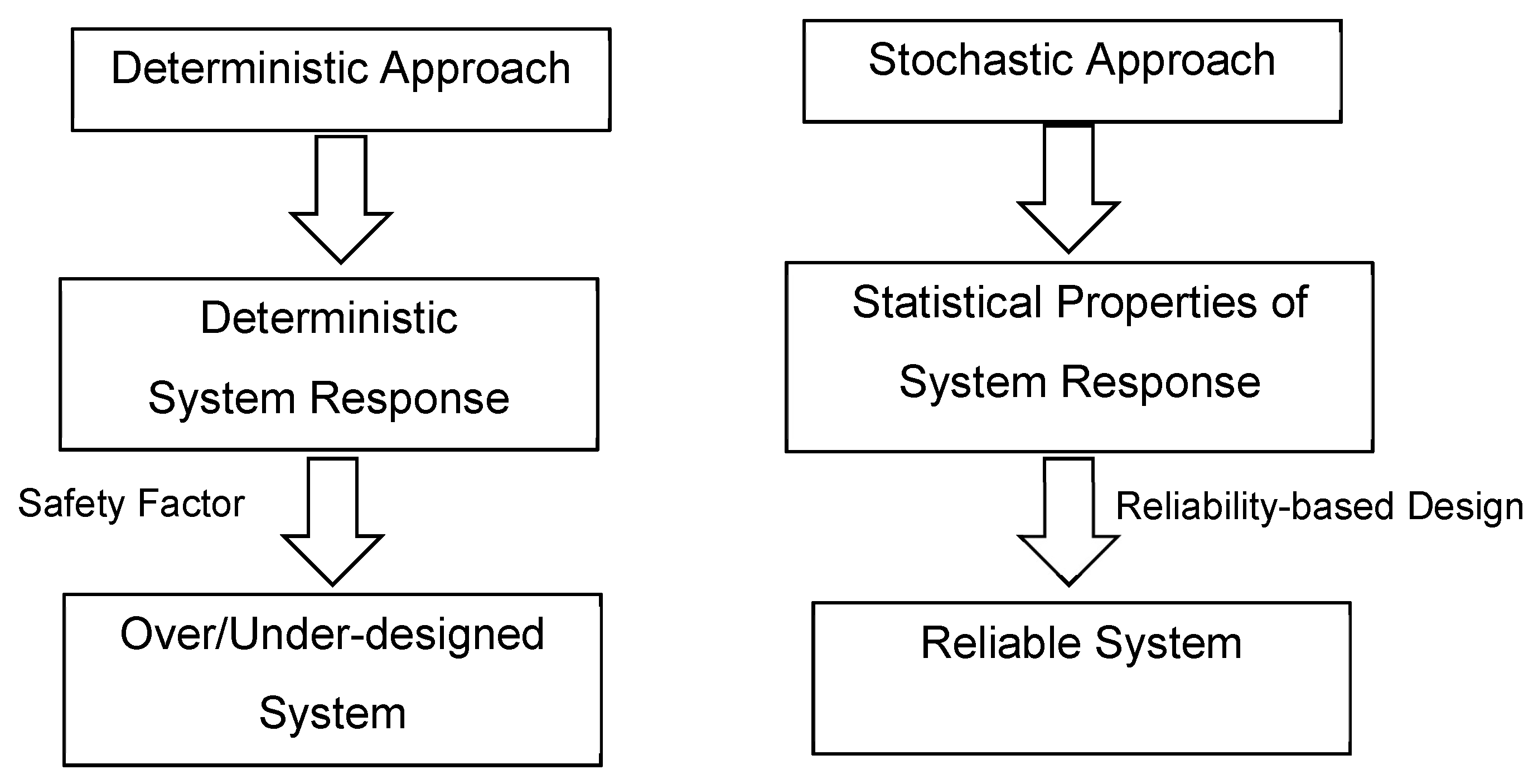
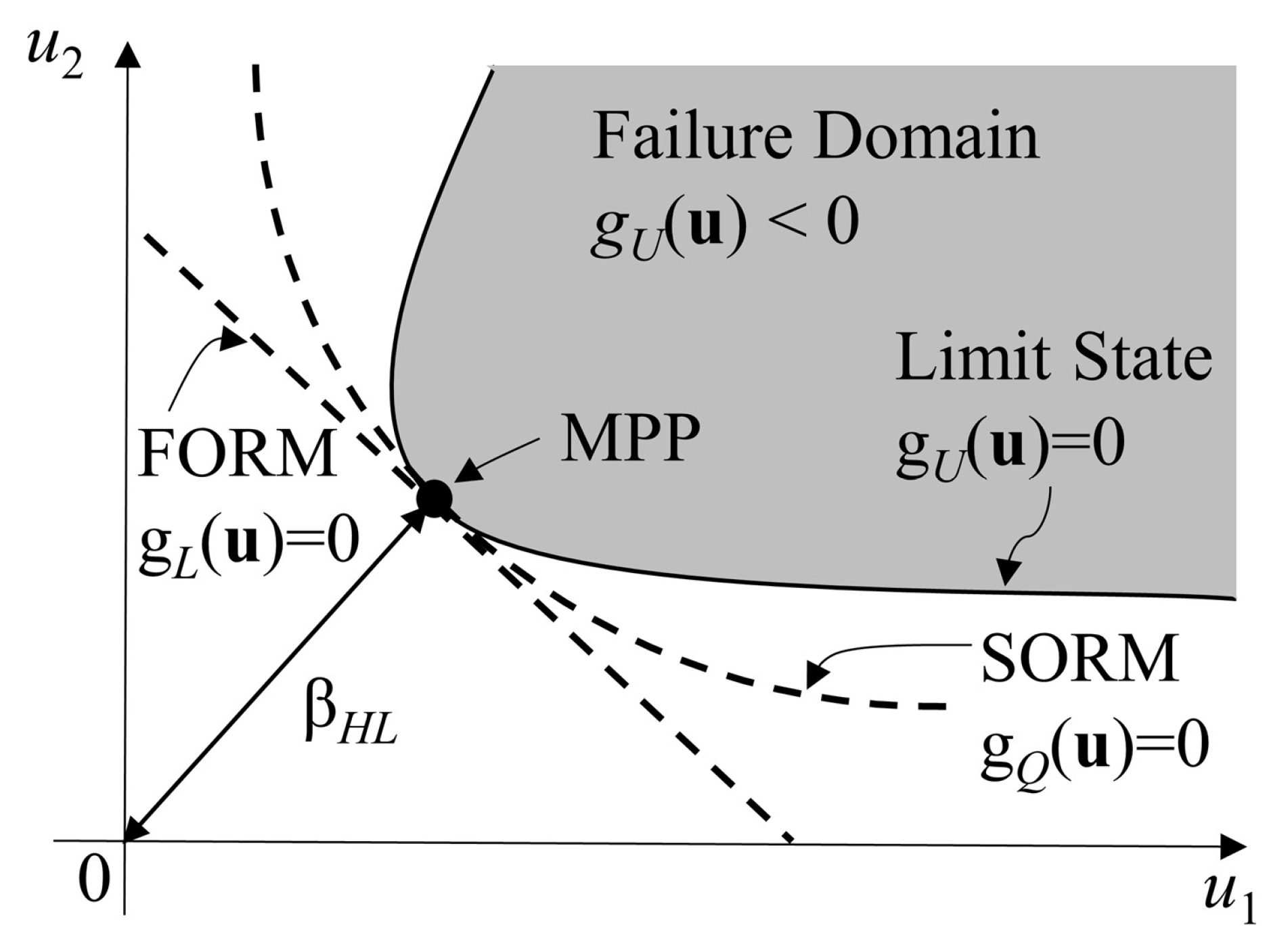
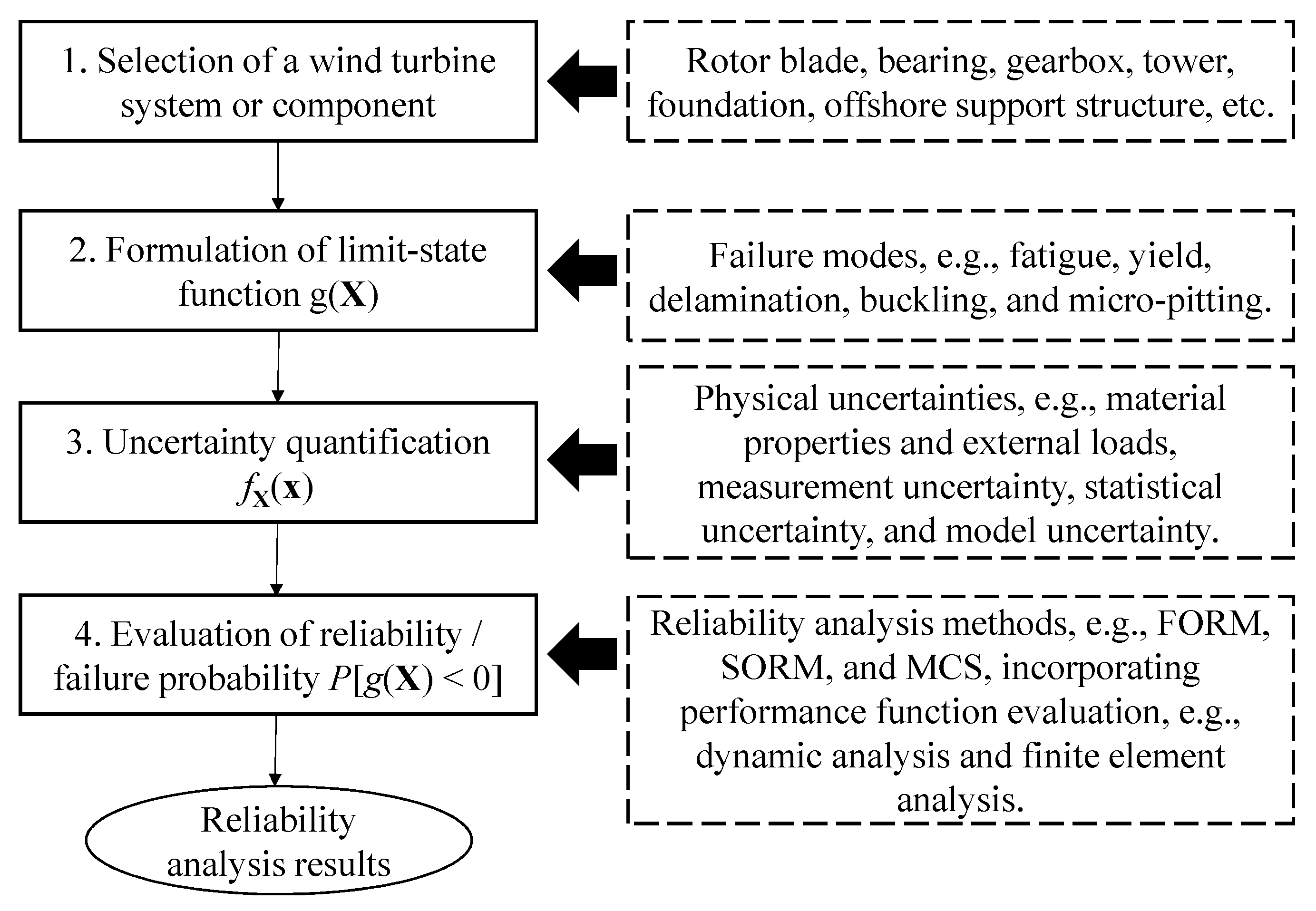
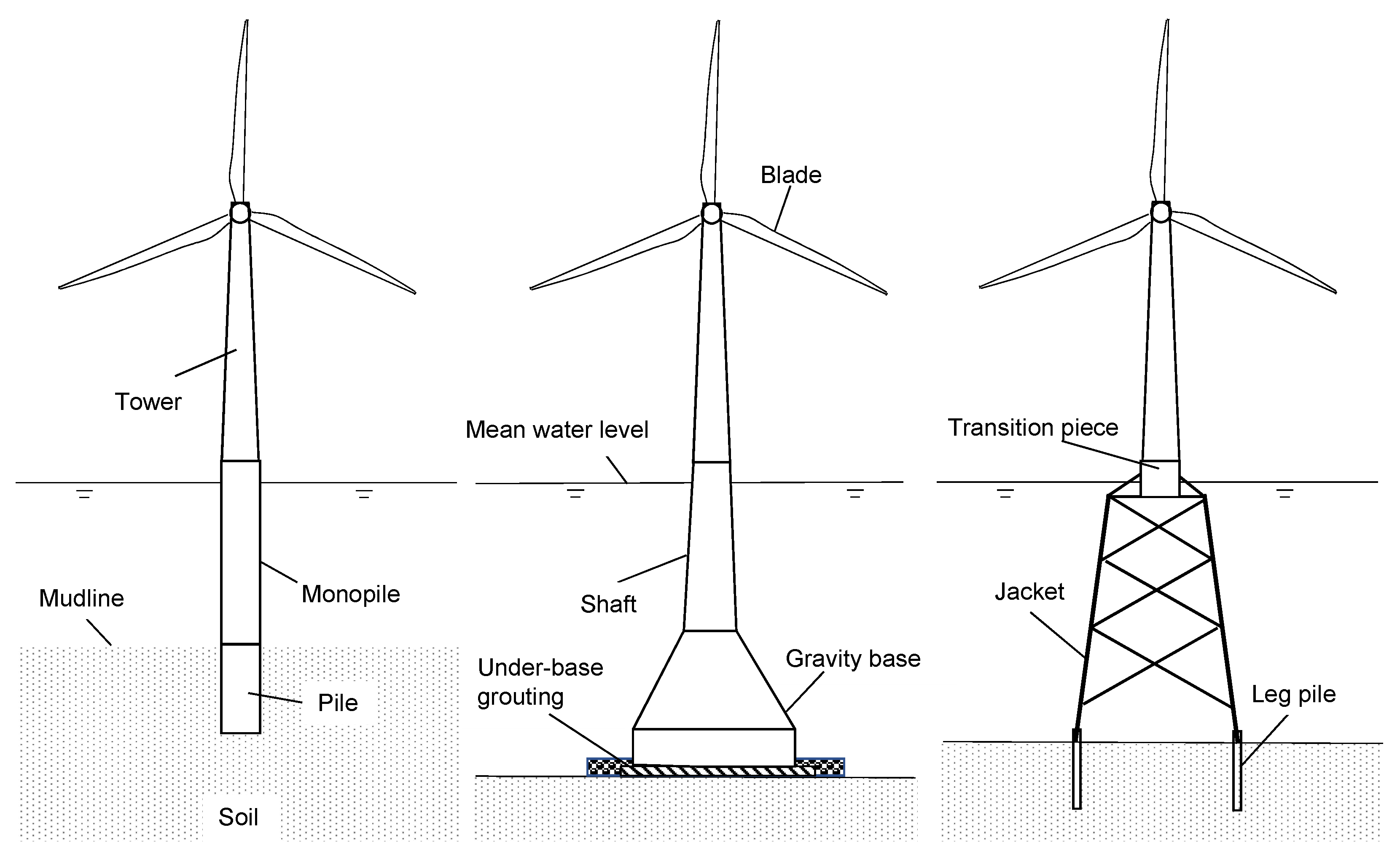
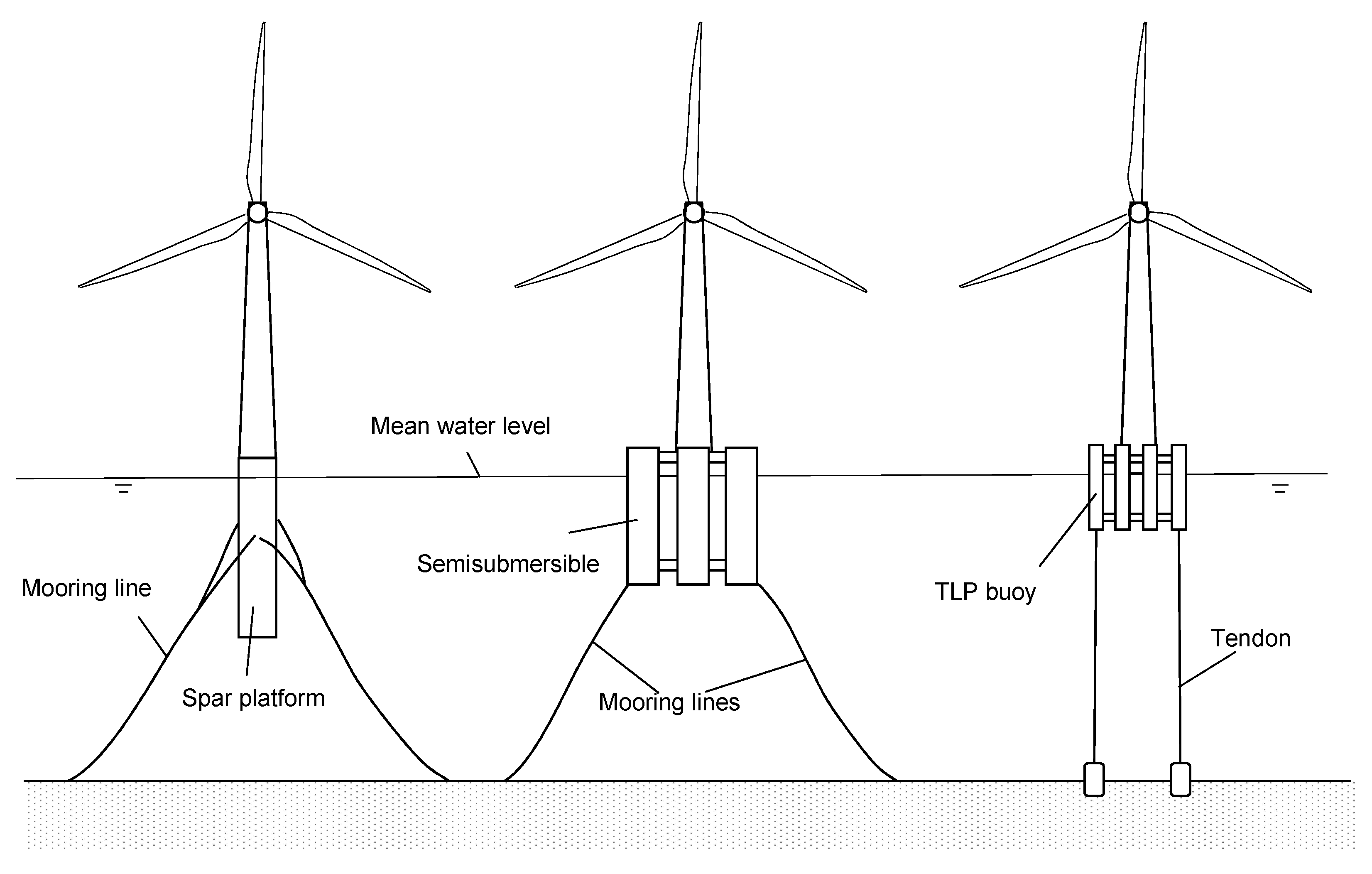
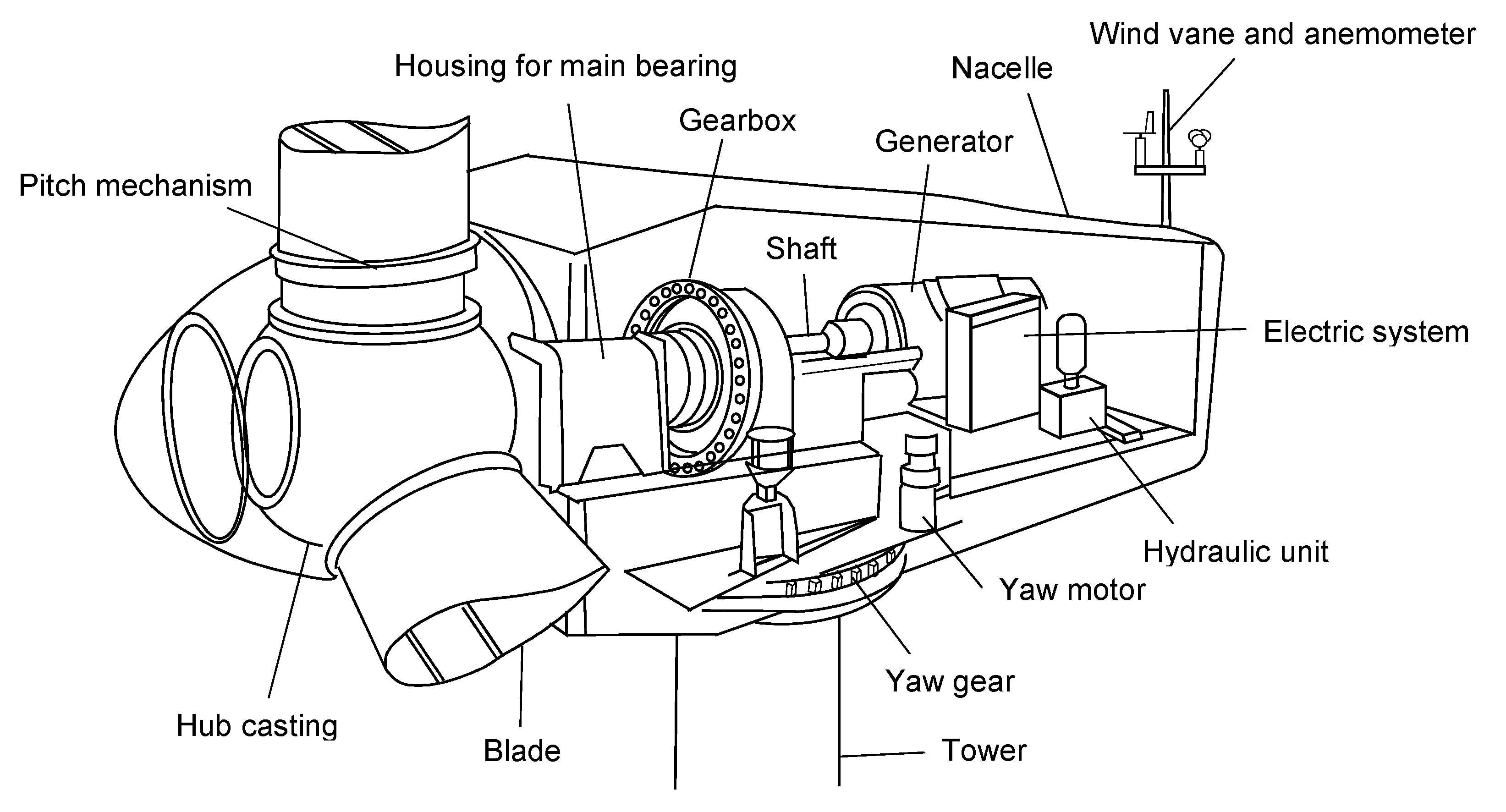
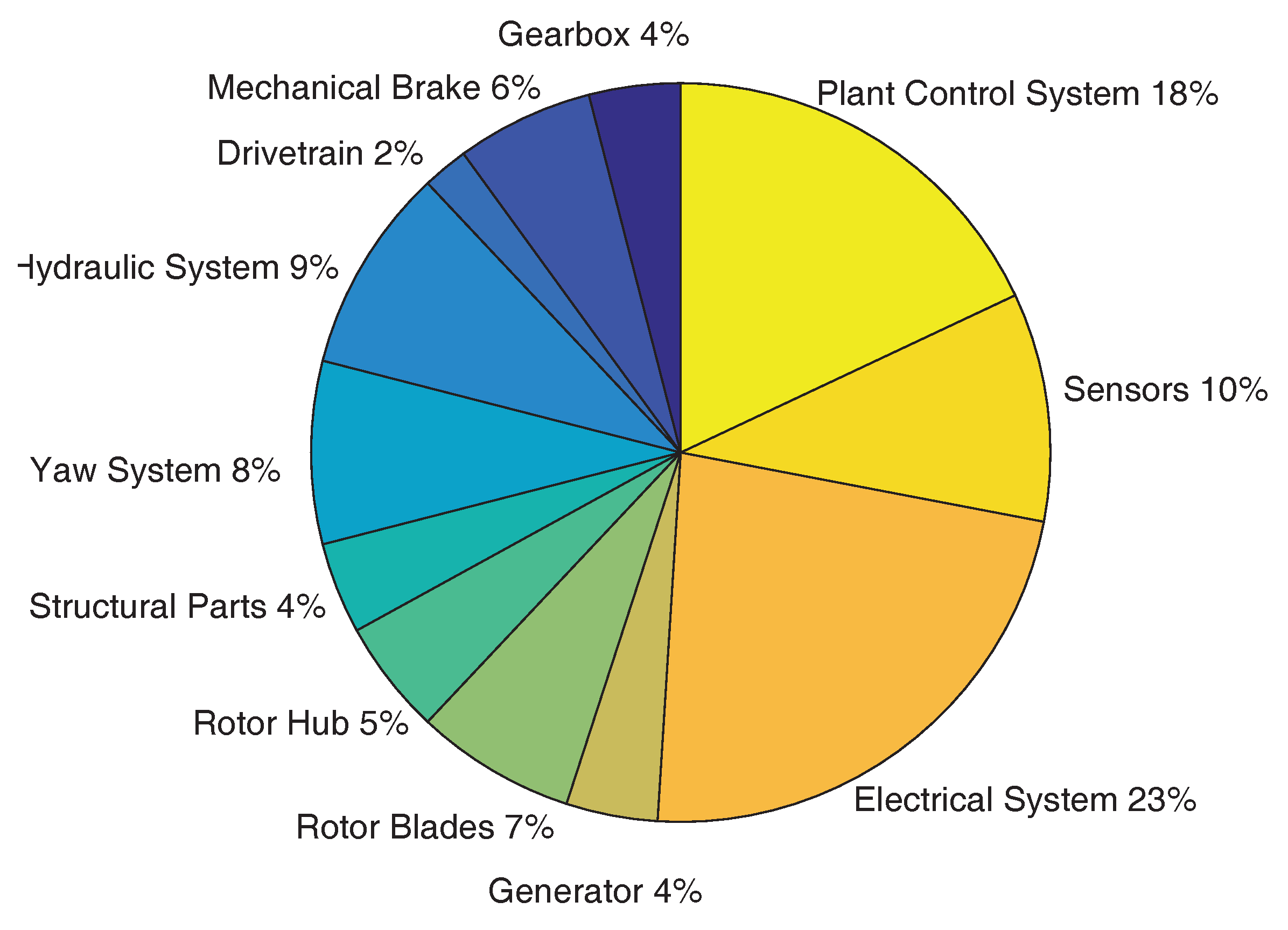
| Category | Component | Failure Modes | References |
|---|---|---|---|
| Rotor blades | blade | excessive bending stress, fatigue, buckling, large deformation | [17,40,42] |
| Bottom-fixed support structures | tower | excessive deformation, fatigue, yielding, and plastic collapse | [26,43,44] |
| grouted connection | fatigue, loss of axial, torsional, bending moment and shear capacities | [45] | |
| gravity-based foundation | loss of bearing capacity, soil failure | [46] | |
| tubular structure | fatigue, large displacement | [18,25] | |
| Mechanical components | shaft | fatigue | [47] |
| gear | contact fatigue, bending fatigue | [48,49,50] | |
| bearing | rolling contact fatigue, white etching crack, skidding | [51,52,53,54] | |
| Electrical components | solder elements | creep and fatigue, bond wire lift-off | [55,56,57] |
| Floating system | mooring lines | extreme load and line breakage | [58,59] |
| Category | Reliability Method | References |
|---|---|---|
| Rotor blades | FORM | [ 40,41] |
| MCS | [ 60,61] | |
| MCS with RSM | [ 42] | |
| Bottom-fixed support structures | FORM | [ 18,35] |
| MCS with RSM | [ 62,63] | |
| nonstandard methods, e.g., IWWA, PRF | [ 24,25,64] | |
| Mechanical and electrical components | FORM | [ 48,49,56] |
| Floating system | MCS | [ 58,65] |
© 2017 by the authors. Licensee MDPI, Basel, Switzerland. This article is an open access article distributed under the terms and conditions of the Creative Commons Attribution (CC BY) license (http://creativecommons.org/licenses/by/4.0/).
Share and Cite
Jiang, Z.; Hu, W.; Dong, W.; Gao, Z.; Ren, Z. Structural Reliability Analysis of Wind Turbines: A Review. Energies 2017, 10, 2099. https://doi.org/10.3390/en10122099
Jiang Z, Hu W, Dong W, Gao Z, Ren Z. Structural Reliability Analysis of Wind Turbines: A Review. Energies. 2017; 10(12):2099. https://doi.org/10.3390/en10122099
Chicago/Turabian StyleJiang, Zhiyu, Weifei Hu, Wenbin Dong, Zhen Gao, and Zhengru Ren. 2017. "Structural Reliability Analysis of Wind Turbines: A Review" Energies 10, no. 12: 2099. https://doi.org/10.3390/en10122099
APA StyleJiang, Z., Hu, W., Dong, W., Gao, Z., & Ren, Z. (2017). Structural Reliability Analysis of Wind Turbines: A Review. Energies, 10(12), 2099. https://doi.org/10.3390/en10122099





